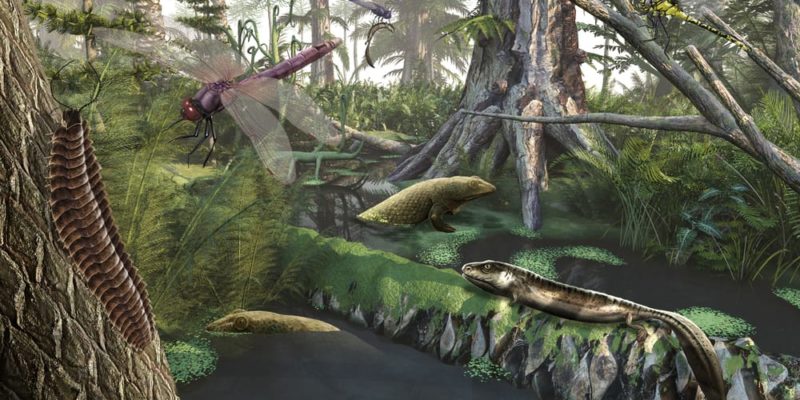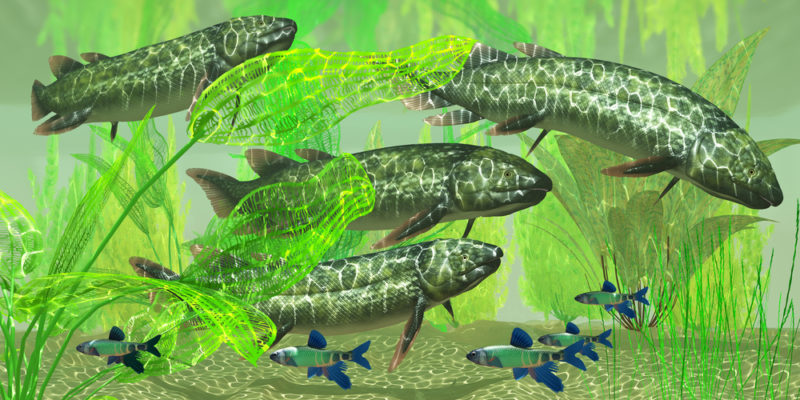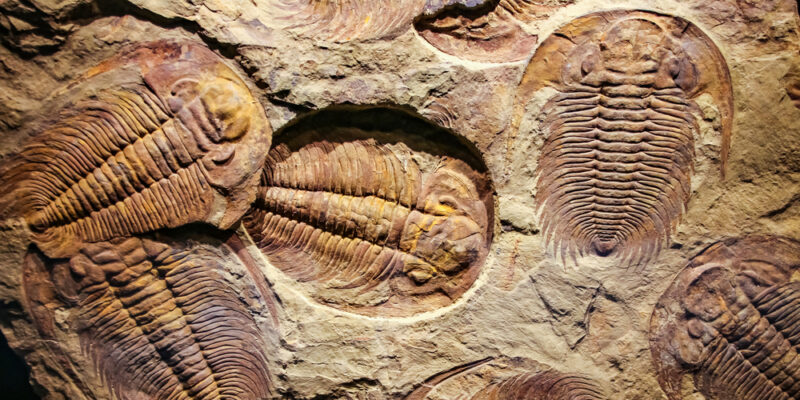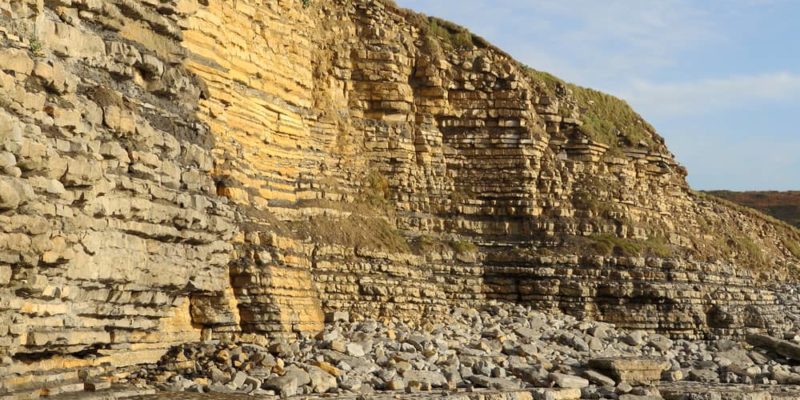We explore the Carboniferous Period, and discuss its characteristics and divisions. In addition, we describe its climate, flora and fauna.

What was the Carboniferous Period?
The Carboniferous is the second-to-last period of the Paleozoic Era. It began approximately 354 million years ago and ended 290 million years ago, spanning a total interval of 64 million years. It is the fifth period of the Paleozoic, succeeding the Devonian and preceding the Permian, and it is also the most extensive. From the point of view of tectonic activity, it was one of the most active periods in the entire geological history of the Earth.
During the Carboniferous, many major climatic changes occurred that were essential for life on the planet. During this period, forests arose and spread, and the first vertebrate animals and insects proliferated. A characteristic of the Carboniferous is the size that plants and insects reached, since increased oxygen levels during this period caused them to thrive and grow to gigantic dimensions.
The name Carboniferous, which derives from the Latin words carbo ("coal") and fero ("bearer"), was coined by British geologists William Conybeare and William Phillips in 1822. It is so named due to the massive amounts of coal that formed on the planet during this period.

- See also: Cenozoic Era
Characteristics of the Carboniferous Period
The main characteristics of the Carboniferous Period are:
- It began 354 million years ago and ended 290 million years ago.
- It is divided into two subperiods: the Mississippian and the Pennsylvanian.
- Plant life was abundant.
- Oxygen levels were much higher than they are today.
- Fossilized vegetation formed massive coal deposits, which give the period its name.
- The climate was predominantly warm and humid.
- Plants and insects reached colossal proportions.
- The supercontinent Pangea was made up of two subcontinents during this period: Gondwana and Laurasia.
Division of the Carboniferous Period

The Carboniferous is divided into two subperiods:
- Mississippian Subperiod. It began 354 million years ago and ended about 323 million years ago. It was characterized by a relatively warm and humid climate. During this subperiod, seas covered vast expanses of continental landmass. Swamp forests were formed, leading to an immense buildup of plant matter, which later became major coal deposits.
- Pennsylvanian Subperiod. It began 323 million years ago and ended about 290 million years ago. Warm climate continued during this period, causing the rise of large vegetation and the diversification of fauna. It was in this subperiod that the major coal deposits that give the Carboniferous its name were formed.
Geology of the Carboniferous Period
During the Carboniferous Period, the continents began to come together, leading to the formation of the supercontinent known as Pangea. This movement of the tectonic plates also produced significant effects on the crust, especially the formation of volcanoes and mountains, as well as the occurrence of large-scale seismic activity.
Later in this period, Pangea began to split again into two subcontinents: Gondwana, which drifted southward, and Laurasia, which remained within equatorial regions.
Climate of the Carboniferous Period
The climate during the Carboniferous Period was predominantly warm and humid. This was mainly due to the fact that much of the supercontinent Pangea lay near Earth’s equator. Thus, the climate was characterized by high temperatures and elevated humidity, which caused rainforests and swamps to form.
Evidence suggests that the Carboniferous Period also experienced cooling and glacial periods, since the part of Pangea known as the subcontinent Gondwana began to drift southward towards lower temperature regions. Though these glaciations were not as intense as those that would occur in later periods, there is evidence of their existence through glacial deposits and valleys.
The other subcontinent, known as Laurasia, remained in equatorial latitudes, so extensive warm-climate rainforests continued to form.
Flora and fauna of the Carboniferous Period

In no other geological period was there such a proliferation of plants as in the Carboniferous. The fossilization of plants into huge coal deposits is what gives the period its name.
Large arborescent seed ferns, trees, and other species flourished, lasting until the Permian period, when the increase in the number of herbivorous animals curbed the spread of flora. Fungi greatly diversified during the Carboniferous, as only few animals fed on them.
Animal life during the Carboniferous was varied. In the seas, invertebrate animals, such as echinoderms, brachiopods, sponges, and trilobites, thrived, while their predators were fish and chondrichthyans (of the shark family). The first amphibians originated, many of which retained fish-like features but were capable of breathing outside of water.
Major coal deposits

During the Carboniferous, the Earth was covered by vast expanses of swamp forests, which were home to an extraordinary variety of plant life. These plants thrived in warm, humid conditions, and given the lack of microorganisms and enzymes to decompose them, the buildup of organic matter in the wetlands and swamps was enormous.
As plants died, their remains built up, forming layers of plant matter that did not fully decompose. Thus, the pressure and heat resulting from sedimentation over millions of years gradually transformed plant matter into massive carbon deposits.
These deposits became a valuable resource in later times, playing a vital role in the Industrial Revolution and in shaping modern society. The coal extracted from these geological formations was used as a source of energy, powering industrial machinery, electricity production, and transportation in the late 19th and early 20th centuries.
Increased oxygen levels in the atmosphere
During the Carboniferous, plant life greatly spread due to the warm climate and high humidity levels. As a consequence of the photosynthetic activity of plants, oxygen levels in the atmosphere increased significantly, reaching 35% (which is much higher than the current concentration of 21%).
This large amount of oxygen supported the expansion of animal life, especially arthropods, whose respiratory system was directly related to the abundance of oxygen in their environment.
Oceans also changed due to raised oxygen levels: marine ecosystems thrived and organisms diversified.
Increased atmospheric oxygen levels during the Carboniferous caused plants and insects to reach gigantic proportions. The medullosa, a characteristic plant of the period, had seeds the size of an egg. Among the fossils found were those of dragonflies over 5 feet long (1.5 m), and scorpions 3 feet in length (1 m).
Explore next:
References
- National Geographic. (2010). Período carbonífero. https://www.nationalgeographic.es/
- Sabadell, M. A. (2022). Carbonífero: la época de las plantas y los insectos gigantes. Muy Interesante. https://www.muyinteresante.es/
- Tarbuck, E. y Lutgens, F. (2005). Ciencias de la Tierra. Una introducción a la geología física. Pearson Educación.
Was this information useful to you?
Yes NoThank you for visiting us :)